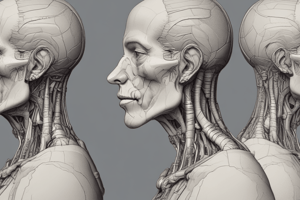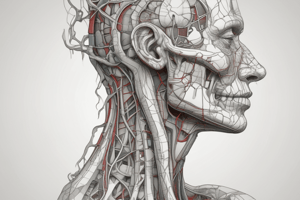Podcast
Questions and Answers
What are the nasal cavities a part of?
What are the nasal cavities a part of?
- The auditory system
- The upper parts of the respiratory tract (correct)
- The oral cavity
- The upper parts of the digestive tract
What forms the floor of the oral cavity?
What forms the floor of the oral cavity?
- Soft palate
- Hard palate
- Soft tissues (correct)
- Bone and cartilage
What are the openings to the nasal cavities?
What are the openings to the nasal cavities?
- Paranasal sinuses and maxillary sinuses
- Nares and choanae (correct)
- Oral fissure and oropharyngeal isthmus
- Ears and orbits
What is the function of the paranasal sinuses?
What is the function of the paranasal sinuses?
What is the location of the maxillary sinuses?
What is the location of the maxillary sinuses?
What separates the oral cavity from the nasal cavities?
What separates the oral cavity from the nasal cavities?
What is the main function of the muscles in the face?
What is the main function of the muscles in the face?
What is the approximate boundary of the posterior neck?
What is the approximate boundary of the posterior neck?
How many major compartments are in the neck?
How many major compartments are in the neck?
What contains the cervical vertebrae and associated postural muscles?
What contains the cervical vertebrae and associated postural muscles?
What is the function of the two lateral vocal folds in the larynx?
What is the function of the two lateral vocal folds in the larynx?
What is the shape of the pharynx?
What is the shape of the pharynx?
Flashcards are hidden until you start studying
Study Notes
Head and Neck Overview
- The head and neck are anatomically complex areas of the body
- The face is the anterior aspect of the head and contains a unique group of muscles
- The scalp covers the superior, posterior, and lateral regions of the head
Neck
- The neck extends from the head above to the shoulders and thorax below
- Its superior boundary is along the inferior margins of the mandible and bone features on the posterior aspect of the skull
- The inferior boundary of the neck extends from the top of the sternum, along the clavicle, and onto the adjacent acromion
- The posterior neck is higher than the anterior neck to connect cervical viscera with the posterior openings of the nasal and oral cavities
Neck Compartments
- The neck has four major compartments, which are enclosed by an outer musculofascial collar
- The vertebral compartment contains the cervical vertebrae and associated postural muscles
- The visceral compartment contains important glands (thyroid, parathyroid, and thymus), and parts of the respiratory and digestive tracts
- The two vascular compartments, one on each side, contain the major blood vessels and the vagus nerve
Larynx and Pharynx
- The neck contains two specialized structures associated with the digestive and respiratory tracts—the larynx and pharynx
- The larynx is the upper part of the lower airway and is attached below to the top of the trachea and above to the hyoid bone
- The larynx has a hollow central channel, and the dimensions of this central channel can be adjusted by soft tissue structures associated with the laryngeal wall
- The pharynx is a chamber in the shape of a half-cylinder with walls formed by muscles and fascia
Head Compartments
- The head is composed of a series of compartments, which are formed by bone and soft tissues
- The cranial cavity, two ears, two orbits, two nasal cavities, and an oral cavity are the main compartments of the head
- The nasal cavities are the upper parts of the respiratory tract and are between the orbits
- The oral cavity is inferior to the nasal cavities, and separated from them by the hard and soft palates
Studying That Suits You
Use AI to generate personalized quizzes and flashcards to suit your learning preferences.



